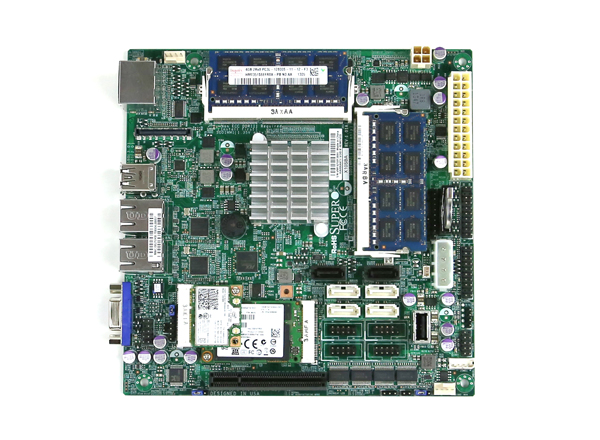Recently AMD escalated the low power processor competition by releasing its AM1 Kabini processors. These processors combined low power Jaguar cores with Radeon R3 graphics. These platforms retail for well under $100 US with processors and motherboards. Intel on the other hand is discounting previous generation processors and selling numbers as well as having launched the Silvermont based Bay Trail-D. We are taking a look at some of these options today.
Test Configurations
Since the Intel examples are all embedded, we were slightly constrained by the platforms we had on hand. Still, we did manage to get a fairly good set of platforms together.
AMD AM1 Kabini processors
- CPU: AMD Sempron 2650, AMD Sempron 3850, AMD Athlon 5130, AMD Athlon 5350
- Motherboard: ASUS AM1I-A
- Memory: 8GB (2x4GB) DDR3 1600MHz
- SSD: Samsung 840 Pro 256GB
- OS: Ubuntu 13.10 server
- Power supply: PicoPSU 150XT
Intel Celeron J1900 Platform
- CPU: Intel Celeron J1900
- Motherboard/ Platform: Supermicro X10SBA
- Memory: 8GB (2x4GB) DDR3 1600MHz
- SSD: Samsung 840 Pro 256GB
- OS: Ubuntu 13.10 server
- Power supply: PicoPSU 150XT
Intel Celeron 1007U Platform
- CPU: Intel Celeron 1007U
- Motherboard/ Platform: Gigabyte GA-C1007UN-D
- Memory: 8GB (2x4GB) DDR3 1333MHz
- SSD: Samsung 840 Pro 256GB
- OS: Ubuntu 13.10 server
- Power supply: PicoPSU 150XT
Intel Celeron 847 NUC Platfrom
- CPU: Intel Celeron 847
- Platform: Intel NUC DCCP847DYE
- Memory: 8GB (2x4GB) DDR3 1333MHz
- SSD: Crucial M500 240GB mSATA
- OS: Ubuntu 13.10 server
- Power supply: Included with NUC
The Supermicro motherboard costs significantly more because it has features such as dual Intel i210 NICs and an additional storage controller. That also means the power consumption is a bit higher than typical consumer parts. There are Intel Celeron J1900 consumer options in the $70-$95 range that are similar save for some of the add-on features present on the Supermicro motherboard. The Intel NUC we purchased for $120 (normally $150) but it does include a chassis and power supply and there are Intel Celeron 847 processor and motherboard options available for under $40. The bottom line is that for all of these platforms, the motherboard plus processor cost is under $100 as of April 2014. We used stock included cooling with all platforms. We also added an old Intel Atom S1260 server we had lying around that represents Centerton which was really one of the last of the “old guard” Atom processors.
Low Power Platform Benchmarks
We are using our standard 2013 STHbench Linux benchmarking suite to get an idea about low power platform performance. As a direct result of user feedback, we recently had the benchmarks all put into a single script that you can use to benchmark your own systems. As development has progressed on the next version we have moved the current script to Linux CPU Benchmarks – Download and Instructions as a resource on the forums. That guide has three simple commands that you can use with a stock installation to run our test suite and install/ compile all necessary files. No configuration is needed. For the next generation development version which currently can also run on CentOS and Mint, and expands the suite to include sysbench and redis-benchmark results, look here: (see Introducing the STHbench.sh Server Benchmarking Script). The net goal is that we want others to be able to reproduce benchmarks and compare directly to their systems. Since we do not have access to every possible configuration, we would appreciate feedback in that thread which can be as simple as posting log files to run. Help is always appreciated!
Hardinfo Performance
hardinfo is a well known Linux benchmark that has been around for years. It tests a number of CPU performance aspects. One major advantage is that one can run this out of the box from many Ubuntu installations.
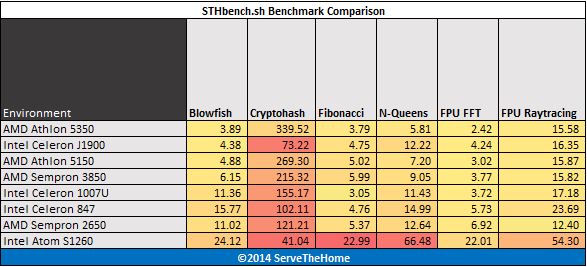
Without an 8 core Silvermont based offering in the mix, the AMD Athlon 5350 is basically the fastest of the bunch.
UnixBench 5.1.3 Performance
UnixBench may be a defacto standard for Linux benchmarking these days. There are two main versions, one that tests single CPU performance on that tests multiple CPU performance. UnixBench segments these results. We run both sets of CPU tests. Here are the single threaded results:

In single threaded tasks, the older Celeron 1007U and 847 both lead the pack with the Celeron J1900 just behind. AMD’s single threaded performance cannot compete here.

As we go to multi-threaded benchmarks we see that there is a good mix of the different vendor representatives. Of course, the Athlon 5350 (chip only) is about $5-10 less than the least expensive embedded Celeron J1900 platforms but suffice to say we are looking at performance here.
c-ray 1.1 Performance
c-ray is a very interesting ray tracing benchmark. It provides both consistent results and some clear separation. Ray tracing is generally a great multi-threaded CPU benchmark. For this test we use both a simple 7500×3500 render and a more complex 1920×1200 render. Here are the results:

The c-ray 1.1 results are interesting. Although our whetstone tests have the Athlon 5350 clocked slightly faster than a Celeron J1900, our c-ray benchmark is not so kind to Intel in this segment. One can also see a pattern. Compared to the 2 core 4 thread Intel Atom generations that were popular for years, the lowest-end Sempron 2650 is still about four times as fast.
Phoronix Test Suite Performance
We are using four tests from the Phoronix Test Suite: pts/stream, pts/compress-7zip, pts/openssl and pts/pybench.
- STREAM by John D. McCalpin, Ph.D. is a very well known memory benchmark benchmark.
- 7-zip compression benchmarks were a mainstay in our Windows suite so we are including it again on the Linux side as a compression benchmark.
- The pts/openssl benchmark is very dependent on the CPU architecture being used
- Python is a widely used scripting language and pyBench is a nice single-threaded Python benchmark
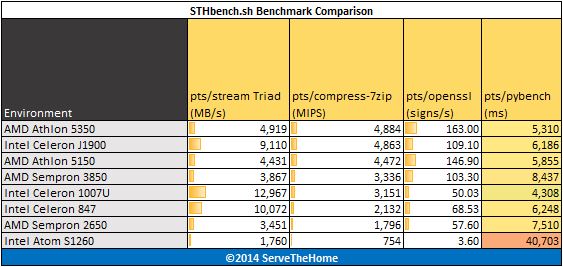
The newer Intel designs continue to benefit in our STREAM Triad benchmark because of their dual memory controllers. 7-Zip is relatively close with our openssl benchmark favoring AMD designs.
Crafty Chess Performance
Crafty is a well known chess benchmark. It is also one where we saw issues last time with the Phoronix Test Suite and running on ARM CPUs. We are planning to retire this benchmark in the 2014 version of STHbench. Here are the Crafty Chess results from simply running “crafty bench”:
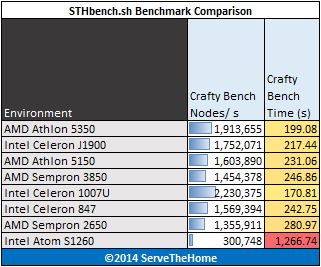
Crafty is very sensitive to clock speeds as a single threaded application and therefore we see the bigger Celeron 1007U cores and the higher clocked parts perform well here.
A word on power consumption
We did a bit of re-testing on some of the older platforms. One variable we could not change was that the Atom S1260 still had an active BMC which consumes (relatively) quite a bit of power at this end of the spectrum.
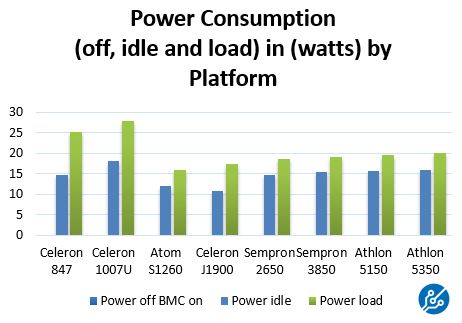
In terms of power consumption, there is a huge rift. Frankly, the Intel Celeron J1900 dominates environmental because it is passively cooled, just like the Atom S1260. Without the need for active cooling, noise, vibration and CPU cooling fan power consumption are non-existent. From a percentage perspective, there is a major jump from Intel’s 22nm process up to larger process nodes. From a nominal perspective, the AMD AM1 Kabini line is still very competitive.
Conclusion
This is a very difficult segment and is fiercely competitive. Taking a step back, we are talking about just 7 of the solutions that occupy a $40 top to bottom market segment where the processor + motherboard cost is between $60 and $100. Companies like Apple do not even segment within a $40 threshold. Here we have offerings that can vary by 3x in terms of performance and 2x in terms of power consumption. The great part about this segment is that prices change rapidly. In 6 months it is likely that we will see the Celeron 1007U and Celeron 1037U get replaced by Ivy Bridge counterparts which will completely change this landscape again. Recently we have been experimenting with building out a low power cluster in the lab with great results.

